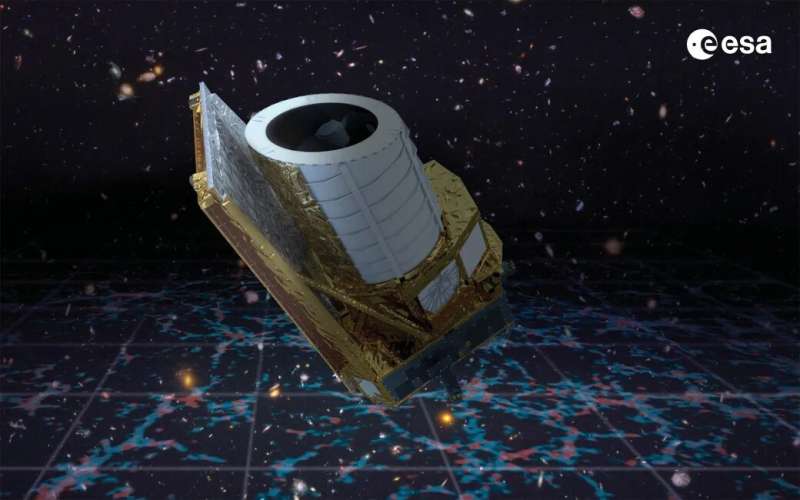This article has been reviewed according to Science X's editorial process and policies. Editors have highlighted the following attributes while ensuring the content's credibility:
fact-checked
trusted source
proofread
Space telescope tracing dark energy to be launched July 1

The Euclid space telescope has a target launch date of July 1, 2023 (18:11 Finnish time at the earliest) with a backup launch date of July 2, 2023.
In six years, Euclid will complete a task that would take older telescopes like Hubble or Webb over a century. The main objective is to solve the problem of dark energy, i.e., why has the expansion of the universe started to accelerate?
A map to reveal the secrets of dark matter and dark energy
The objective of Euclid is to help us understand two of the most enigmatic, yet key phenomena in the universe; dark matter and dark energy.
"The gravity of dark matter and dark energy affects the movements of galaxies and the expansion of the universe. Though we cannot see either of them directly, they make up some 95% of the universe," says Professor Hannu Kurki-Suonio from the University of Helsinki.
Euclid will produce a three-dimensional map of the universe with billions of galaxies. The map will cover over one third of space, up to 10 billion light years away. The further away an observed galaxy is, the further we can see into the past—all the way to 10 billion years ago.
The part of space to be mapped has been selected because that is where the furthermost galaxies are most clearly discernible, avoiding the plane of the Milky Way and our own solar system. Euclid will also measure the gravitational lens effect; how the gravitation of dark matter bends the trajectory of light so that it distorts how we see far-away galaxies. In this way we will be able to map the distribution of dark matter.
The three-dimensional map produced by Euclid will help us study how the universe has expanded and how large-scale structures, like galaxies, have developed during cosmic history. This, in turn, depends on the characteristics of dark matter and dark energy.
Euclid will be launched from Cape Canaveral in Florida with a SpaceX Falcon 9 rocket to 1.5 million kilometers from Earth, where it will be able to make observations without interference. There is a telescope on Euclid with a diameter of 1.2 meters, along with two instruments: one for taking sharp images in visual light, the other one for taking spectra and images in infrared.
Both instruments on Euclid contain a large camera. The images from visible light contain more than 600 million pixels and the ones from infrared more than 60 million pixels.
Euclid will take images from one area for over an hour, and then it will be turned towards another area. Euclid differs from previous space telescopes specifically in that it can take in a much larger portion of space at one time—the portion of space covered by one image is larger than the full moon can conceal.
More than 300 research institutes and 2,000 researchers from 21 countries are participating in Euclid. The total cost of the project is more than 1 billion euros. The observational data from Euclid will be analyzed in nine separate Euclid science data centers, one of which is located in Finland.
The Finnish scientists have collaborated in developing computing methods, producing simulated data, and developing data quality-assurance methods for Euclid. The Finnish members also hold a strong position in combining observations made from Earth with Euclid data. In addition to the data gathered by the space telescope, we also need a huge amount of data collected from Earth in order to determine the distances of galaxies.
"In order to collate all this data, we need long-term collaboration between observatories and data centers around the world, but once it is finished, it will also offer scientists the best material for research into the structure of the universe," says University Lecturer Aku Venhola from the University of Oulu.
"Data-intensive computation is a swiftly growing field within science. The Finnish Euclid science data center is a spearhead example of this," says Director Janne Ignatius from CSC, the IT Center for Science.
"The development of efficient methods of data analysis poses cross-discipline challenges between cosmology and IT," adds Associate Professor Maarit Korpi-Lagg from Aalto University.
Finnish researchers have especially developed methods for computing statistical measures like correlation functions to describe the structure of the universe. After the launch, the Finnish computing center will be responsible for processing 5% of the data from Euclid.
Euclid will start collecting the measurements three months after the launch. The first measurement period will last one year, after which a period of 14 months has been set aside for analysis. The first results from the Euclid project are expected by the end of 2025.
Provided by University of Helsinki





















